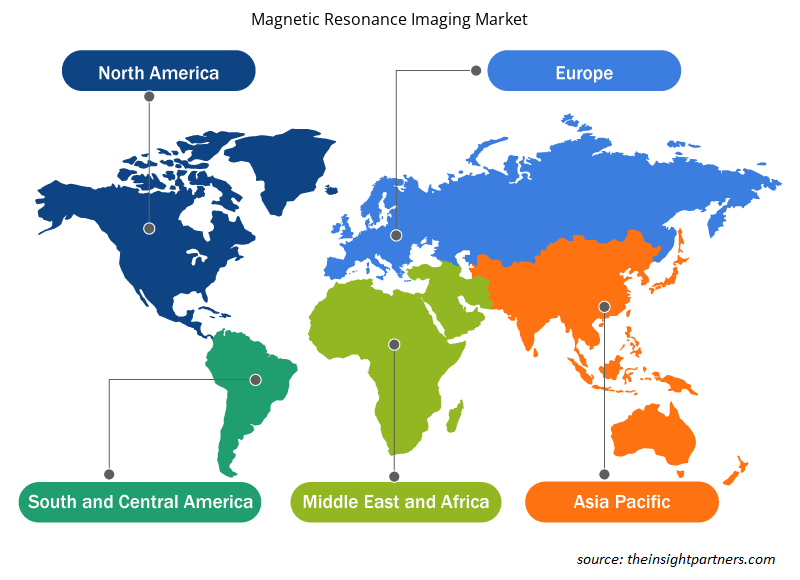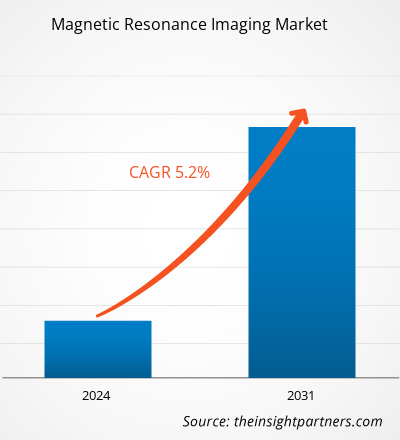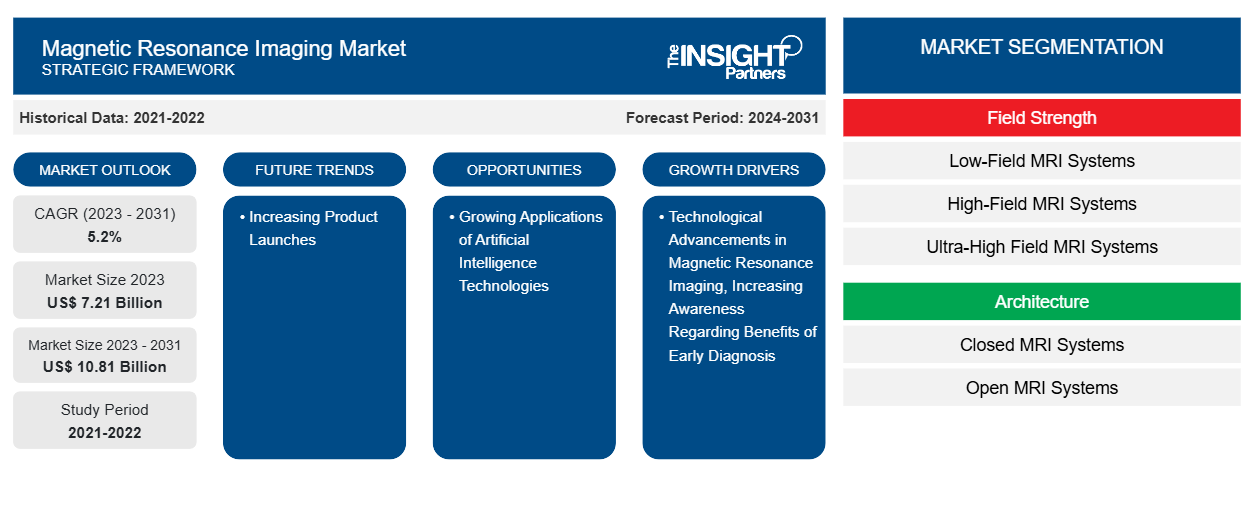Der Markt für Magnetresonanztomographie soll von 7,21 Milliarden US-Dollar im Jahr 2023 auf 10,81 Milliarden US-Dollar im Jahr 2031 anwachsen. Der Markt soll zwischen 2023 und 2031 eine durchschnittliche jährliche Wachstumsrate (CAGR) von 5,2 % verzeichnen. Zunehmende Anwendungen künstlicher Intelligenztechnologien sind ein wichtiger Markttrend für Magnetresonanztomographie.
Magnetresonanztomographie-Marktanalyse
Der Anstieg der alternden Bevölkerung, die Zunahme der Zahl der Krebspatienten, technische Fortschritte im Gesundheitsbereich, die zur Entwicklung neuer und hochmoderner Technologien führen, und das wachsende Bewusstsein für die Bedeutung einer frühen Krankheitsdiagnose, die eine frühzeitige Behandlung ermöglicht, sind einige Faktoren, die das Marktwachstum vorantreiben. Eine Zunahme der Investitionen, die zur Einführung neuer Produkte und finanzierter Projekte zur Verbesserung der MRT-Technologien in der Kinderpflege führen, dürfte die Expansion des Marktes im Prognosezeitraum vorantreiben.
Marktübersicht für Magnetresonanztomographie
Die Magnetresonanztomographie (MRT) ist ein nicht-invasives diagnostisches Bildgebungssystem, das starke Magnetfelder und Radiowellen nutzt, um detaillierte Bilder des Körperinneren zu erzeugen. Die bei der MRT verwendeten Kontrastmittel helfen dabei, anhand der Art der entstehenden Läsionen zwischen gutartigen und bösartigen Tumoren zu unterscheiden . Da chronische Krankheiten in Industrie- und Entwicklungsländern zugenommen haben, ist der Bedarf an medizinischer Bildgebung erheblich gestiegen. Laut dem GLOBOCAN-Bericht 2020 wurden weltweit etwa 19,29 Millionen neue Krebsfälle sowie 9,95 Millionen durch die Krankheit verursachte Todesfälle gemeldet. Laut Daten der OECD Health Statistics sind weltweit 50.000 MRT-Systeme installiert und jährlich werden weltweit über 95 Millionen MRT-Scans durchgeführt. Im April 2021 beteiligte sich Philips an einem wichtigen Forschungsprojekt, um eine potenziell revolutionäre Anwendung der MRT-Technologie in der Kardiologie zu entdecken.
Passen Sie diesen Bericht Ihren Anforderungen an
Sie erhalten kostenlos individuelle Anpassungen an jedem Bericht, einschließlich Teilen dieses Berichts oder einer Analyse auf Länderebene, eines Excel-Datenpakets sowie tolle Angebote und Rabatte für Start-ups und Universitäten.
-
Holen Sie sich die wichtigsten Markttrends aus diesem Bericht.Dieses KOSTENLOSE Beispiel umfasst eine Datenanalyse von Markttrends bis hin zu Schätzungen und Prognosen.
Treiber und Chancen auf dem Markt für Magnetresonanztomographie
Technologische Fortschritte in der Magnetresonanztomographie treiben das Marktwachstum voran
Die MRT ist eine der flexibelsten bildgebenden Diagnosemethoden, die eine Vielzahl von Parametern am lebenden Objekt charakterisieren und eine hervorragende räumliche Auflösung bieten kann. Mehrere aktuelle technologische Entwicklungen haben die Entwicklung der MRT-Techniken in den letzten Jahren geprägt. Zu den technologischen Fortschritten gehört die Einführung der offenen MRT, die eine effiziente Bildgebung bei übergewichtigen oder klaustrophobischen Personen ermöglicht. Diese Fortschritte haben auch die Feldstärke und Rechenkapazität der bildgebenden Geräte verbessert. Aufgrund dieser Eigenschaften wurden die Pulssequenzen der Geräte verbessert, was zu schnelleren Bildgebungszeiten, höherer räumlicher Auflösung und besserer Bildqualität führt. Neue und technologisch fortschrittliche Produkte großer Marktteilnehmer wie MAGNETOM Terra von Siemens, das erste für den klinischen Einsatz zugelassene 7T-MRT-System, sind nur einige der technologischen Fortschritte, die sowohl etablierte Marktteilnehmer als auch neue Marktteilnehmer zur Verbesserung der Qualität und Wirksamkeit von MRT-Scans unternommen haben und das Wachstum des Marktes vorantreiben.
Mehr Produkteinführungen fördern das Marktwachstum
Die wachsende Zahl von Produkteinführungen, gepaart mit der zunehmenden Einführung hochfester Systeme, ist eine der wichtigsten Chancen, die sich den Marktteilnehmern bieten. Technologische Innovationen haben zur Entwicklung und anschließenden Vermarktung hochfester Bildgebungsgeräte geführt. Im August 2023 stellte Unionsminister Dr. Jitendra Singh in Neu-Delhi Indiens ersten im Inland entwickelten, leichten, ultraschnellen, erschwinglichen Hochfeld-MRT-Scanner (1,5 Tesla) der nächsten Generation vor. Im Rahmen der National Biopharma Mission des Department of Biotechnology hat das in Bengaluru ansässige Startup Voxelgrids Innovations Pvt Ltd einen kompakten MRT-Scanner entwickelt, um den ungedeckten Bedarf des Landes zu decken.
Segmentierungsanalyse des Marktberichts zur Magnetresonanztomographie
Wichtige Segmente, die zur Ableitung der Marktanalyse für Magnetresonanztomographie beigetragen haben, sind Feldstärke, Architektur, Anwendung und Endbenutzer.
- Basierend auf der Feldstärke ist der Markt für Magnetresonanztomographie in Niederfeld-MRT-Systeme, Hochfeld-MRT-Systeme und Ultrahochfeld-MRT-Systeme unterteilt. Das Segment der Hochfeld-MRT-Systeme hatte im Jahr 2023 den größten Marktanteil. Darüber hinaus wird erwartet, dass das Segment der Niederfeld-MRT-Systeme im Prognosezeitraum die höchste durchschnittliche jährliche Wachstumsrate verzeichnet.
- In Bezug auf die Architektur wird der Markt in geschlossene MRT-Systeme und offene MRT-Systeme unterteilt. Das Segment der geschlossenen MRT-Systeme hatte im Jahr 2023 den größten Marktanteil. Darüber hinaus wird erwartet, dass das Segment der offenen MRT-Systeme im Prognosezeitraum die höchste durchschnittliche jährliche Wachstumsrate verzeichnet.
- In Bezug auf die Anwendung wird der Markt in Kardiologie, Onkologie, Neurologie, Gastroenterologie, Bewegungsapparat und Sonstiges unterteilt. Das Segment Neurologie hatte im Jahr 2023 den größten Marktanteil. Darüber hinaus wird für das Segment Bewegungsapparat im Prognosezeitraum die höchste durchschnittliche jährliche Wachstumsrate erwartet.
- Basierend auf dem Endverbraucher ist der Markt für Magnetresonanztomographie segmentiert inKrankenhäuser, ambulante chirurgische Zentren und Diagnosezentren. Das Krankenhaussegment hatte im Jahr 2023 den größten Marktanteil und wird im Prognosezeitraum voraussichtlich die höchste durchschnittliche jährliche Wachstumsrate verzeichnen.
Magnetresonanztomographie Marktanteilsanalyse nach Geografie
Der geografische Umfang des Marktberichts zur Magnetresonanztomographie ist hauptsächlich in fünf Regionen unterteilt: Nordamerika, Asien-Pazifik, Europa, Naher Osten und Afrika sowie Süd- und Mittelamerika.
Nordamerika dominiert den Markt für Magnetresonanztomographie. Die steigende Nachfrage nach innovativen Produkten von Biopharma- und Magnetresonanztomographie-Unternehmen, die Präsenz wichtiger Marktteilnehmer und umfangreiche Forschungs- und Entwicklungsarbeiten zahlreicher Hochschulen und Forschungsinstitute begünstigen das Marktwachstum in der Region. Darüber hinaus stimulieren der zunehmende Fokus auf die Integration fortschrittlicher Methoden in die Gesundheitsversorgung und die hohe Anzahl bildgebender Verfahren aufgrund der zunehmenden Verbreitung chronischer Krankheiten das Wachstum des nordamerikanischen Marktes zusätzlich.
Der asiatisch-pazifische Raum wird in den kommenden Jahren voraussichtlich die höchste durchschnittliche jährliche Wachstumsrate aufweisen. Die zunehmende Einführung innovativer Systeme, eine starke potenzielle Patientenbasis und ein zunehmendes Bewusstsein für fortschrittliche Diagnostik bei zunehmenden Fällen der Krankheit sind einige der Faktoren, die das Marktwachstum in der Region wahrscheinlich unterstützen werden.
Regionale Einblicke in den Markt für Magnetresonanztomographie
Die regionalen Trends und Faktoren, die den Markt für Magnetresonanztomographie im Prognosezeitraum beeinflussen, wurden von den Analysten von Insight Partners ausführlich erläutert. In diesem Abschnitt werden auch die Marktsegmente und die Geografie für Magnetresonanztomographie in Nordamerika, Europa, im asiatisch-pazifischen Raum, im Nahen Osten und Afrika sowie in Süd- und Mittelamerika erörtert.

- Erhalten Sie regionale Daten zum Markt für Magnetresonanztomographie
Umfang des Marktberichts zur Magnetresonanztomographie
| Berichtsattribut | Details |
|---|---|
| Marktgröße im Jahr 2023 | 7,21 Milliarden US-Dollar |
| Marktgröße bis 2031 | 10,81 Milliarden US-Dollar |
| Globale CAGR (2023 - 2031) | 5,2 % |
| Historische Daten | 2021-2022 |
| Prognosezeitraum | 2024–2031 |
| Abgedeckte Segmente |
Nach Feldstärke
|
| Abgedeckte Regionen und Länder |
Nordamerika
|
| Marktführer und wichtige Unternehmensprofile |
|
Marktteilnehmerdichte im Bereich Magnetresonanztomographie: Auswirkungen auf die Geschäftsdynamik verstehen
Der Markt für Magnetresonanztomographie wächst rasant, angetrieben durch die steigende Nachfrage der Endnutzer aufgrund von Faktoren wie sich entwickelnden Verbraucherpräferenzen, technologischen Fortschritten und einem größeren Bewusstsein für die Vorteile des Produkts. Mit steigender Nachfrage erweitern Unternehmen ihr Angebot, entwickeln Innovationen, um die Bedürfnisse der Verbraucher zu erfüllen, und nutzen neue Trends, was das Marktwachstum weiter ankurbelt.
Die Marktteilnehmerdichte bezieht sich auf die Verteilung der Firmen oder Unternehmen, die in einem bestimmten Markt oder einer bestimmten Branche tätig sind. Sie gibt an, wie viele Wettbewerber (Marktteilnehmer) in einem bestimmten Marktraum im Verhältnis zu seiner Größe oder seinem gesamten Marktwert präsent sind.
Die wichtigsten auf dem Markt für Magnetresonanztomographie tätigen Unternehmen sind:
- GE-Gesundheitswesen
- Koninklijke Philips NV
- Siemens AG
- Canon Medical Systems Corporation
- Esaote SpA
- FONAR
Haftungsausschluss : Die oben aufgeführten Unternehmen sind nicht in einer bestimmten Reihenfolge aufgeführt.

- Überblick über die wichtigsten Akteure auf dem Markt für Magnetresonanztomographie
Neuigkeiten und aktuelle Entwicklungen zum Magnetresonanztomographie-Markt
Der Markt für Magnetresonanztomographie wird durch die Erhebung qualitativer und quantitativer Daten nach Primär- und Sekundärforschung bewertet, die wichtige Unternehmensveröffentlichungen, Verbandsdaten und Datenbanken umfasst. Im Folgenden finden Sie eine Liste der Entwicklungen auf dem Markt für Bioabwehr und -strategien:
- Siemens Healthineers hat die neue Produktionsanlage für MRT-Geräte in Bengaluru eingeweiht. Das Unternehmen stellt derzeit MAGNETOM Free. Star her, einen revolutionär einfachen Ansatz für hochwertige MRT in Indien. (Quelle: Siemens Healthineers, Pressemitteilung, 2023)
- FUJIFILM Healthcare Americas Corp. erhielt die FDA 510(k)-Zulassung für sein neues 1,5-Tesla-MRT-System ECHELON Synergy. Das System nutzt Synergy Deep Learning Reconstruction (DLR), Fujifilms proprietäre DLR-Technologie auf Basis künstlicher Intelligenz, um die Bildschärfe zu verbessern und Scans schneller zu erfassen, was zu einem höheren Durchsatz, einer höheren Bildqualität und einer höheren Patientenzufriedenheit beiträgt. (Quelle: FUJIFILM Holdings America Corporation, Pressemitteilung, 2023)
Marktbericht zur Magnetresonanztomographie – Umfang und Ergebnisse
Der Bericht „Marktgröße und Prognose für Magnetresonanztomographie (2021–2031)“ bietet eine detaillierte Analyse des Marktes, die die folgenden Bereiche abdeckt:
- Marktgröße und Prognose auf globaler, regionaler und Länderebene für alle wichtigen Marktsegmente, die im Rahmen des Projekts abgedeckt sind
- Marktdynamik wie Treiber, Beschränkungen und wichtige Chancen
- Wichtige Zukunftstrends
- Detaillierte PEST/Porters Five Forces- und SWOT-Analyse
- Globale und regionale Marktanalyse mit wichtigen Markttrends, wichtigen Akteuren, Vorschriften und aktuellen Marktentwicklungen
- Branchenlandschaft und Wettbewerbsanalyse, einschließlich Marktkonzentration, Heatmap-Analyse, prominenten Akteuren und aktuellen Entwicklungen
- Detaillierte Firmenprofile
- Historische Analyse (2 Jahre), Basisjahr, Prognose (7 Jahre) mit CAGR
- PEST- und SWOT-Analyse
- Marktgröße Wert/Volumen – Global, Regional, Land
- Branchen- und Wettbewerbslandschaft
- Excel-Datensatz
Aktuelle Berichte
Erfahrungsberichte
Grund zum Kauf
- Fundierte Entscheidungsfindung
- Marktdynamik verstehen
- Wettbewerbsanalyse
- Kundeneinblicke
- Marktprognosen
- Risikominimierung
- Strategische Planung
- Investitionsbegründung
- Identifizierung neuer Märkte
- Verbesserung von Marketingstrategien
- Steigerung der Betriebseffizienz
- Anpassung an regulatorische Trends























 Kostenlose Probe anfordern für - Markt für Magnetresonanztomographie
Kostenlose Probe anfordern für - Markt für Magnetresonanztomographie